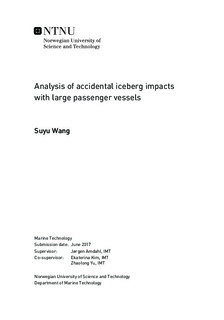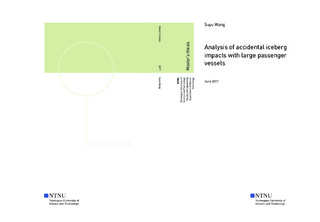| dc.description.abstract | The number of collisions between ships and ice are increasing with the increase
of ships sailing in Arctic areas. It is necessary to research on large passenger ships
subjected to iceberg impact, since it may cause huge human life loss.
The method to design ice going ship nowadays is presented. The conventional
design of ship structures is carried out in the ULS format. But the design of ship-iceberg
impact scenario should fall into ALS design, due to its rare and large load
property. ULS design for ship-iceberg collision will yield over-designed structures.
The method to get the design ice load according to IACS Polar Class rules is
introduced. The design method is based on simplified method and it doesn t take
the ship-iceberg collision into consideration.
For engineering calculations it is common to decouple the collision event into
external and internal mechanics. The basic ideas about splitting the impact process
into these two parts is introduced. Some numerical simulation cases in Liu s paper
are also presented to give a more clear introduction. The internal mechanics depends
on the relative strength of the ship structures and Iceberg, so it is necessary
to establish an accurate ice material model. The most important mechanical and
physical properties of ice are described. The material model for iceberg developed
by Liu is also presented. The numerical simulation using this ice material is also
presented to show that this ice material model is validated.
The major work in this master thesis is to establish an FE model for both ship
structures and ice floe, and then run impact simulations in Ls-Dyna. The establishment
of FE model of ship structures and Ice floe is introduced in detail. The
impact analysis setup in Ls-Dyna prepost is also presented. Some key points about
how to get appropriate numerical simulation results are presented for anyone who
wants to do this kind of analysis again.
The simulation results are presented in detail. Basically, the ship is designed
with enough resistance against ice floe impact load. The ship can crush the ice
completely without being significant damaged. One simulation was run using rigid
material, and the ship shell was easily penetrated. The damage pattern of the ship
structures is analyzed for this simulation. Some simulations were run with an error,
which makes the ice uncrushable. In these cases, the ice floe will cause significant
deformation on the ship shell but not penetrate it. The results are also presented to
make a comparison with the crushed ice. | |

